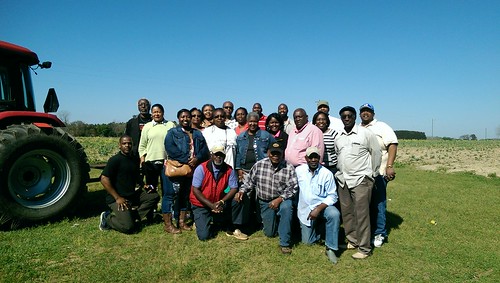
USDA StrikeForce team with partner McIntosh SEED to bring information to rural Georgia.
Today, one-in-six Americans lives in poverty, according to the U.S. Census Bureau—and 90 percent of counties with the highest poverty rates are in rural America. These are also communities with high numbers of historically underserved groups, like African Americans, Hispanics, Asian Americans and Native Americans.
Last year, McIntosh Sustainable Environment and Economic Development (SEED) partnered with USDA’s Natural Resources Conservation Service (NRCS) with the goal of improving delivery of NRCS programs to Georgia’s socially disadvantaged farmers and ranchers in USDA StrikeForce counties. SEED is a grassroots, community-based organization with a mission to improve social, economic, environmental and cultural interests of the community while providing quality education, better housing, recreational facilities, business opportunities and environmental protection and restoration.
“The partnership has been a great opportunity for us to work directly with farmers and others to help bring NRCS resources to communities that may not have been aware of the agency’s various programs and conservation mission,” said the executive director for SEED, John Littles.
By partnering with local community-based organizations, three USDA agencies—NRCS, Farm Service Agency (FSA) and Rural Development (RD)—are working to improve the Department’s outreach to increase access and participation in the agencies’ technical and financial assistance programs. Through StrikeForce, they have laid a foundation of cooperation and collaboration that has better served our customers.
Rotating public meetings throughout locations in Georgia has enabled SEED to reach more underserved farmers and ranchers. “NRCS’ help has grown these communities and built their economies through conservation programs. It’s created jobs, and will keep doing so,” said Littles.
In the past year, numerous full and part-time jobs have been created, and additional jobs will be specifically targeted for young people—primarily high-school students—in an effort to get them more involved with their communities. SEED hopes the results will be a better appreciation for the importance of agriculture in their daily lives. The programs also teach goal-setting, how to plan special events, and general clerical skills.
When asked what he sees as the long-term result of these programs, Littles said the future looks bright. “We’re improving lives now while simultaneously creating the next generation of farmers.”
Agriculture Secretary Tom Vilsack established USDA’s StrikeForce Initiative for Rural Growth and Opportunity in 2010 to address the specific challenges associated with rural poverty. With StrikeForce, USDA agencies take a multi-disciplinary approach by working with community partners to create jobs, feed kids, assist farmers, secure safe homes and conserve natural resources. StrikeForce teams have collaborated with more than 1,500 community partners and public entities to invest $24 billion to bring targeted assistance to rural areas experiencing chronic poverty. USDA StrikeForce teams operate in 880 counties in 21 states and Puerto Rico and provide an opportunity for NRCS to work with underserved landowners to determine how best to leverage available financial assistance and address natural resource concerns—with an emphasis on historically underserved communities in rural counties with persistent high poverty.
A recent University of Georgia Center for Agribusiness and Economic Development report by Sharon P. Kane and Kent Wolfe found that in the 60 designated Georgia StrikeForce counties, the USDA funding investments were associated with 5,340 jobs and $790.1 million in output impact to the economy in 2011; 4,713 jobs and $722.8 million in output in 2012; and 5,242 jobs and $845.3 million in output in 2013. The economic contribution of USDA investments in the StrikeForce counties resulted in a multiplier effect of 1.73 in terms of employment and 1.54 in terms of output.
Learn more about how StrikeForce can help landowners. To get started with NRCS, visit your local USDA Service Center or www.nrcs.usda.gov/GetStarted.
No comments:
Post a Comment
Note: Only a member of this blog may post a comment.